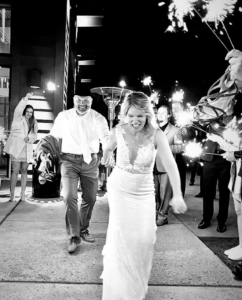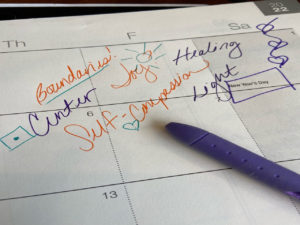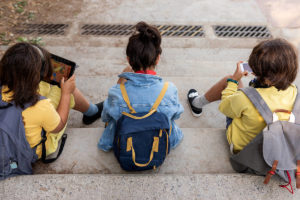|
psychologist, trainer, consultant
Dr. Amy
Featuring Articles for HEALTH CARE PROVIDERS, EDUCATORS, AND PARENTS
Welcome to the Blog
Have a topic idea? Reach out to me at info@doctoramyllc.com with your ideas!
SUBSCRIBE TO THE NEWSLETTER

Hello Friends,
Yes, I know this is late. I mean, it’s February now and if I was on my “A-game” I would have sent this to all of you in December. But COVID. And Holidays. And my kids returned to distance learning for 10 days. And, if I really practice some self-compassion, it’s ok to be tardy because some thoughts are valid even when they are late. So, here we are in February setting some ground rules for this year.
- Set some boundaries. Decide “what’s OK” and “what’s not ok” and be prepared for this to feel new and awkward. Some of you might be great with boundaries while others are still learning. Know that some people are heading into 2022 like, “Screw this, I’m over COVID” while others are like, “This is never going to end,” and still others are like, “Hope is on the horizon, but we’re not there yet.” Where do you fall? What boundaries do you need to feel confident and protected? For instance, be ready to talk about whether you’re ready to give hugs, high fives or fist bumps. Own whether you’ve returned to work, you’re scared to, or you’re appreciating the new normal of a hybrid model. Begin to think about and express your boundaries – clear is kind!
- Be ready for some tough conversations. Everyone is hungry to “return to some semblance of normal.” But what that means for you may be vastly different than what it means for others. You don’t have to justify your position. You don’t have to be defensive of what feels appropriate for you. If you’re still hunkered down because your risk tolerance is low and your concern for infection is high, that’s ok. If you’re beginning to dip your toe into the waters of gatherings and dinners out, that’s ok too. Just know that when you bump into others who are from another camp, that might be hard or shaky – be willing to sit with hard conversations.
- Respect where other people are as a way of showing kindness. See number 2 above – it’s normal for us to be all over the gamete in terms of socialization, risk, and health. Let other people find their way. You never know what someone else is carrying.
- Your personal life and your professional life can be separate. The past two years muddled those two together out of necessity and process. Let’s begin to untangle the two. Separate home life from work life so you can begin to find greater balance. Create physical space and emotional space. When possible, leave work at work.
- Have some rules and expectations for your children’s mental health for 2022. Let educators know. Let policymakers know. Talk about this as a family. Re-visit themes of mental health with your children. So many of them are fragile right now.
- Acknowledge how you’re feeling as we enter year three of navigating a global pandemic. Are you angry? Confused? Overwhelmed? Resigned? Talk about the space you are in with other adults that care about you. They are having big feelings now too. You’re not alone.
- Establish some norms and expectations to have a sense of predictability at work and at home. Revisit these every few months to see how they feel. The lack of predictability over the past 2 years has created a huge sense of vulnerability. Let’s begin to create some structure where we can.
- Fear is not a good advisor. Get information from established resources and trusted advisors. Make decisions from a place of knowledge versus stress. We live in a polarizing world where topics can feel highly politicized or black-and-white. Rarely are things that clear. Find people and advisors who know you and whom you trust.
- This is not over. While so many geographic areas, settings, organizations, and spaces are seeing some reprieve, many are not. Be gentle with healthcare organizations, educators, and service providers. They were the first hit by this pandemic and will be the last to recover.
Geez, when I was brainstorming these ground rules, I used my voice memo app on my phone. I didn’t realize I only had NINE rules and now I feel incomplete without adding one more to have a solid 10.
10. Embrace imperfections. Enough said.
Be well, my friends. Reach out for help. Tell me more about your ground rules for 2022 or what I missed. I love hearing from you.
Want more? My Provider Retreat is coming up in May — registration is open! Learn more and register here.
With compassion,
Dr. Amy
Hello Friends,
Well, last week’s newsletter was a hit! And so reflective for many of you. Thank you for taking the time to respond with thoughtful ideas. So many of you offered your words and contemplations regarding this activity. Here were some highlights:
- Pause
- Balance
- New
- Thoughtful Purpose
- Anchor
- Essential
I wanted to highlight one particular reflection that stood out to me. This particular word gave me goosebumps, made me pause and helped me realize we ALL need this word, especially now!
ESSENTIAL. I chose it to remind me that I always have a choice in how I think, what I say, what I do, and how I choose to spend my time and talents. I will focus on things that I find essential: self-care, joy, letting things go, not worrying about what others think about me, how I spend my money, and even what foods I decide to eat and how I take care of my body. Only that which is ESSENTIAL will be my focus.
Friends, do you feel me? This statement from a subscriber really had an impact on me. There are so many stressors in our lives right now and so many of you have told me that, amidst this pandemic, the situation feels hopeless. Let’s focus on what is essential. I love this so much!
I’m continuing to reflect and have added another phrase to my list: nourishing relationships. Doesn’t that sound paramount? So often, we give of ourselves in relationships that are not reciprocal. We do so out of obligation, promise, and social expectations. But we don’t often take inventory of relationships that are not giving back to us, not nourishing, and not give-and-take.
Those relationships that are energy-depleting and soul-sucking need to be reconsidered and at the very least, balanced with nourishing, shared meaningful connections.
That’s where I’m at this week. Others? More thoughts and phrases?
Thanks for continuing to share.
With compassion,
Dr. Amy
|
||||
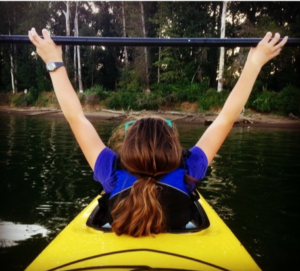
Friends,
As we enter the month of December and all-things holiday merry-making, I want to remind you that it’s ok to feel overwhelmed. Almost 2 years into a global pandemic, I know most healthcare providers are still reeling from what they’ve been through. If you’re like me, it’s as if the last two years have been an eternity. So, just a short reminder from author Brianna Weist that self-care is often unbeautiful. It’s not about eating better, sleeping more and exercising – but often about tough choices and creating boundaries. It’s certainly something to ponder as we enter the holiday season of mounting obligations.
Here you go:
Self-care is often a very unbeautiful thing.
It is making a spreadsheet of your debt and enforcing a morning routine and cooking yourself healthy meals and no longer just running from your problems and calling the distraction a solution.
It is often doing the ugliest thing that you have to do, like sweat through another workout or tell a toxic friend you don’t want to see them anymore or get a second job so you can have a savings account or figure out a way to accept yourself so that you’re not constantly exhausted from trying to be everything, all the time and then needing to take deliberate, mandated breaks from living to do basic things like drop some oil into a bath and read Marie Claire and turn your phone off for the day.
A world in which self-care has to be such a trendy topic is a world that is sick. Self-care should not be something we resort to because we are so absolutely exhausted that we need some reprieve from our own relentless internal pressure.
True self-care is not salt baths and chocolate cake, it is making the choice to build a life you don’t need to regularly escape from.
And that often takes doing the thing you least want to do.
It often means looking your failures and disappointments square in the eye and re-strategizing. It is not satiating your immediate desires. It is letting go. It is choosing new. It is disappointing some people. It is making sacrifices for others. It is living a way that other people won’t, so maybe you can live in a way that other people can’t.
It is letting yourself be normal. Regular. Unexceptional. It is sometimes having a dirty kitchen and deciding your ultimate goal in life isn’t going to be having abs and keeping up with your fake friends. It is deciding how much of your anxiety comes from not actualizing your latent potential, and how much comes from the way you were being trained to think before you even knew what was happening.
If you find yourself having to regularly indulge in consumer self-care, it’s because you are disconnected from actual self-care, which has very little to do with “treating yourself” and a whole lot do with parenting yourself and making choices for your long-term wellness.
It is no longer using your hectic and unreasonable life as justification for self-sabotage in the form of liquor and procrastination. It is learning how to stop trying to “fix yourself” and start trying to take care of yourself… and maybe finding that taking care lovingly attends to a lot of the problems you were trying to fix in the first place.
It means being the hero of your life, not the victim. It means rewiring what you have until your everyday life isn’t something you need therapy to recover from. It is no longer choosing a life that looks good over a life that feels good. It is giving the hell up on some goals so you can care about others. It is being honest even if that means you aren’t universally liked. It is meeting your own needs so you aren’t anxious and dependent on other people.
It is becoming the person you know you want and are meant to be. Someone who knows that salt baths and chocolate cake are ways to enjoy life – not escape from it.
-Brianna Wiest
Grateful for you in all the ways you show up – for yourself and for others!
Dr. Amy
Hello Friends,
I just returned from a few days away. If you’re like me, it feels like you pay a high price to take a vacation. You’re swamped with work prior, organizing kids, creating order in your home, and checking to be sure clients/patients will be ok. Then, after your return, you can anticipate hours of catch-up, returning emails, putting out fires, and diving back into work.
But you know what – it doesn’t matter as long as you have extended moments of relaxation and disconnect. For four days I went to bed when I was tired. I woke up when I was rested. I worked out as long as I wanted/needed and ate food that sounded yummy. I read books and felt the sun on my face. I had date nights and ate nachos with margaritas for lunch. It was glorious.
If I’m honest, I had a couple of meetings that could not be put off. And you know what? I showed up refreshed, recharged, and full of ideas. There was no resentment or fatigue. I was funny (I think!) and offered great ideas – it’s amazing how much more clearly we think and how we contribute when we’re not exhausted.
I know it can feel impossible to find the time. I know we can feel guilty to leave kids or co-workers behind. But I promise you – you’re a better partner, parent, co-worker, helper, provider, sibling, and friend if you take a break. We cannot continue to put off taking care of our mental and physical health. I know organizations are overwhelmed right now. I know the message is “we need you” and “we’re short-staffed.” You cannot help anyone if you are spread so thin that you are overwhelmed and exhausted every day.
So, maybe you don’t have a week to take off. Here’s what you can do:
- In a week, get out of town – go somewhere that’s calling your name. For me, that means warm weather and sunshine. Or enjoy a staycation – explore your city/town with new eyes. Go to the museums and shops that have suffered during shutdowns and support local businesses.
- In a few days, drive away – get out of cell service, visit a new town, spend a few days downtown, and site see in your own city. Camp, explore, hike. Try one new activity while you’re out that you’ve never done before. Pot throwing anyone?
- In a day – drive somewhere for a beautiful hike. Spend the whole day watching TV or reading a book in bed. Order food in. Walk throughout your neighborhood and breathe. Don’t tell anyone…
- In a half-day – turn off your phone for a few hours, garden or plant something that regenerates, tap into your creative brain through painting, sewing, or drawing. Explore a bookstore. Meet a friend for lunch. Go to the movies by yourself and eat the whole bucket of popcorn.
- For an evening – make what YOU want for dinner. Have someone over in your backyard and listen to music. Call friends or family that you haven’t spoken to in a while. Disconnect from everyone and sit outside or read a book with a sign on your door that says, “do not disturb” for an hour.
We want to create a life that we don’t have to escape from AND at the same time, we all need breaks from the monotony and stress of it. It’s ok to take a break. It’s ok to ask someone to look over people you love or care for while you’re gone. Give yourself the compassion that you give others.
With kindness,
Dr. Amy
Hello Friends,
This newsletter is a follow-up to a Facebook post on my professional page. I promised all of you I would give you an insider peek at how I handle screens and social media – in my home, with my kids!
First, there are tremendous resources and guidance out there. You can look to the American Academy of Pediatrics, Common Sense Media, and American Psychological Association for hard and fast data around recommendations for screens and social media use. My colleague Doreen Dodgen-Magee has fabulous information and support on her website and in her books. But what I’m going to lay out is my personal experiences and the choices I’ve made as a parent when it comes to screens and social media for my kids. Perhaps this information will feel like a helpful guide. Perhaps it will feel validating. Or, perhaps it will make you scream and feel frustrated with me because it seems unrelatable. Let me know and here we go!
Recently, I agreed to allow my 16-year-old daughter to have a one-month trial on Snapchat. Why? Because everyone has it. Because everyone communicates this way. Because I’m the only mom who’s held out this long. Really? Well, we’re two weeks into her one-month trial and she hasn’t even downloaded the app. So, I began to wonder why. And I truly believe that because of how we’ve handled screens and social media, it’s taken away some of the allure that makes it all so darn compelling. So, what follows is an outline of my general rules and practices when it comes to screens and social media.
- Under the age of 2 – nada. Nothing. I remember turning Sophia away from screens when she was little. My friends made fun of me but I was determined. That meant, no TV, computer, no playing with adults’ phones.
- Toys that were old-school. With so many things that light up, twirl, and play music, we tried to stick with low-tech.
- When my kids got a bit older, we began to dabble with some short shows. Again, I went old-school. I knew what the research said about kids’ attention span and how shows adapted to constantly change in order to keep kids’ attention. So, instead, we watched Mr. Roger’s Neighborhood, old Sesame Street re-runs, and cartoons like Caillou.
- Also, when they were little, screens were used for me! If I needed 20 minutes to take a shower or prepare dinner, out came Bernstein Bears. And we used them as something special vs. something given.
- Days did not start with screens. I let their brains warm up. Days started with play, stuffed animals, breakfast and reading books.
- Disney and Pixar – nope. Sorry. Not until my kids were 4 or 5 years old. I know it sounds nutty, but I realized that EVERY Disney movie had a child who’d lost a primary attachment figure in some form. Ugh!
- When I allowed them to watch longer animated movies, it was very intentional. Usually, we watched them together so I could pause, ask them questions about what they understood, or fast forward through inappropriate parts.
- As a general rule, adults didn’t have the TV on unless we were watching a movie or show. And when kids were around, it was not adult-content themes. This means that watching the news, Law & Order or Grey’s Anatomy waited until after bedtime. And you’re right, I was often so tired, it meant nothing at all.
- Movies – Yes, I was that mom. I didn’t allow my kids to watch PG 13 or R movies until they were much older. At 14 & 16 they only recently began to watch some R movies.
- Video games – my daughter was never quite interested. My son never had a video game system in our home until about 5th or 6th grade – and then it was a Wii, followed by an X-box.
- Content – this is really important. As my son wanted to play video games, I said NO to explicit themes. I said Yes to sports games, Mario Cart, and fitness. If you have nothing, those are REALLY fun. He never played a “shooter” game until 7th going into 8th grade. And then, with lots of restrictions.
- As my kids got older, neither had a cell phone until 7th grade. And the first cell phones were NOT smart phones. My son just got a smartphone in 8th grade, updated from his flip phone. (He says he still misses the simplicity of his flip phone!).
- Restrictions – lots of them.
- Time limits on all screens. I set them and I check them weekly.
- No screens in bedrooms.
- No explicit content.
- Lots of talking about online predators, “friending” people, and an open policy where I could look at search history at any time.
- They must earn the right to a smart phone by showing responsible flip-phone behavior.
- All apps on smart phones are approved through me.
- Social media – My daughter got IG in middle school because it felt the “safest” of all. She had to be a “friend” of mine. And we had a lot of discussions about online predators, friends, and post content. My son is a freshman and still has no social media. He had to make a choice to have his X-box and a new, more explicit game, or social media. He chose video games because it was still a way to be online with friends.
- Choices – while it might seem like I’m pretty strict, I give lots of choices. I say yes to a lot of creative apps, photos, and choosing between acceptable social media. IG – yes. Tik Tok – not yet. Snapchat – short trial.
At the end of the day, we talk A LOT about screens, social media, and video games. When I’m doing the talking it’s about safety, respect, and the black hole that kids can fall into online with porn and bullying. And, I ask a lot of questions about their use, their friends’ use, and what other kids are doing. Then, I keep my mouth shut while they talk. I ask more questions.
OK, that’s a lot more than I thought I was going to share. What questions are you left with? What else would be helpful to know? Shoot me an email and let me know how this is sitting with you.
Until then, much compassion to you,
Dr. Amy
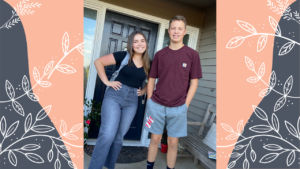
Hello Friends,
Well…have you settled into the school year with your kiddos? I don’t know about you, but I had this mix of relief and anxiety. Let me tell you a funny conversation I had with my kids when they BOTH headed out to school this week.
Me: Have a great first day (after lots of ridiculous first-day pictures, sans masks).
Jack: Mom, what are you going to do without us?
Me: I’m sure I’ll manage…and I’ll miss you (Also me: happy dance as they drove off).
Here’s the thing. On one hand, I’ve loved having my kids at home. Never in the recent history of raising teenagers have we had the opportunity to have so much time with them. On the other hand, I am NOT a teacher and, it turns out, I’m pretty horrible at it. For the most part, we have managed with the help of a huge village to support all of us. AND, it’s been really hard on them – socially, emotionally, and academically.
And yet, even after 18 months at home and way too many days of distance learning, saying goodbye was hard. I realized as I dropped off my freshman for his first day of in-person high school that this might be the last opportunity. Because his sister drives (and soon he will drive) I’ll have to be intentional about creating those moments. And watching my daughter drive them both to school on day 2 was heart-wrenching. My two loves driving away – confident yet anxious; excited yet conservative. And let me tell you – dropping off a 3-year-old, 10-year-old, or 14-year-old is ALL hard! You’re leaving a little part of your heart at school.
So, I want to focus on the return. There’s so much research on the importance of being there for our kids when they return to us, in any capacity. So, whether you’re picking them up, they’re driving home, you’re meeting at a bus stop, or arriving at after-care – those first interactions are precious and important. They set the stage for the rest of the afternoon/evening. While we can’t prevent the need to say goodbye, we can decide how the return will look. Here are a few ideas:
- Be present. Put down your phone, laptop, etc., and be available to check-in.
- Ask open-ended questions. “What was an interesting part of your day?” will get more responses than “How was school?”
- Be curious. “Tell me about your music teacher. What seemed hard? What kind of music will you study?”
- Be excited about their learning. “Wow, that seems cool! I’ve never taken a class like that before.” Or “How did you make that? Draw that? Build that?”
- Let them know you’re happy they’re home. “I’m so glad you’re here. I missed you today.” Or, “I can’t wait to hear more.”
- Feed them and water them. Like plants and animals, they need tending to and often kids forget to eat and drink enough during the day.
- Talk about homework later. I promise there will be plenty of time to talk about homework as the night wanes on, but allow the first moments to simply connect.
So, while goodbyes never get easier, we can get better at welcoming our kids back into us – back into relationship a with you.
With compassion,
Dr. Amy
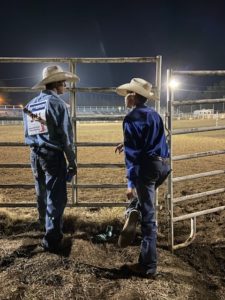
Hey Friends,
Let me be straight with you. I really despise dust & dirt. So, being hot and standing outside in addition to dust and dirt feels pretty miserable. Now add horses, manure, sweating, setting up tents and pens and standing with a horse in hand for what feels like hours…It leads me to wonder why I didn’t push basketball more. Sheesh!
And, did I mention, I REALLY LOVE baseball and football. The smell of the field, the anticipation of plays, watching incredible feats of athleticism. Sigh… I even coached boys’ baseball, I understand football (don’t be jealous!) and I truly revel in team sports. But, that’s not my son. He’s not passionate about those sports, I am.
A few years ago, he found western riding, specifically the world of rodeo. I naively encouraged him to take a “cowboy camp” and now, three years later, we’re all-in. As we navigated our first high school rodeo this past weekend, it occurred to me that so many parents push their kids into sports and activities so that they can live through their kids. If that were the case, I’d have Jack in quarterback camps year-round. But Jack does not love football. I do. Jack does not love team sports. I do. Jack loves horses and being a cowboy. So, I’ve had to shift my focus and commitment as well. I’ve had to reframe my values and emphasize skills he’s learning on his horse and at the barn.
Through rodeo, Jack benefits from a multitude of factors. Through rodeo, he’s found family. He’s found a community that would give you the shirt off of their backs and commit to living on fairgrounds for days at a time. At the end of the day, we’re all dusty and tired, but the smiles on our kids’ faces are priceless. Jack has also found grit and dedication. He’s the only one in the arena who catches or misses a calf. His horse does not care if it’s 110 degrees outside or raining sideways – she needs water, hay and caretaking. And if he doesn’t show up to practice, he’s letting himself down and it will show in his competitions. And, as a family, we’ve found a sport that gives as much as you give to it. I’ve never seen a bunch of kids that work harder, have greater respect for animals and a huge commitment to family than I have in the rodeo world.
So, what activity does your kid TRULY love? And are you all-in for him or her? Or, are you wishing and pushing towards something that YOU love, but your child is not passionate about? Do you have a young boy who would love to do theater but you’re insistent on sports? Does your daughter love reading and art but you push her towards group clubs? Would your kids revel in volunteering but they’re overcommitted to academics that they’re passionless about?
I’m asking you to take an honest assessment of what activities your child is involved in for YOU and for THEM. Ask yourself, is this club/sport/activity/class for me or for my child? Don’t get me wrong, there are some classes or activities that may be non-negotiable because of your family values and that’s great! Do you volunteer as a family or require religious classes? Great. But when it comes to genuine passionate pursuit for your child – him/her finding THEIR ONE THING THAT THEY LOVE AND WANT TO GIVE 10,000 HOURS TO IN ORDER TO GET BETTER, do they choose that pursuit, or do you?
There’s a lot of miles between our home and the barn or a rodeo. It gives me a lot of time to reflect on my own and talk with my son. One thing I’ve noticed is that I never have to “make” him get ready for the barn. His passion drives his willingness. That’s a great way to assess what your child is truly interested in versus what you’re driving more that he/she is in terms of passion and interest.
Just a few things to consider down this road of parenting. OK, now I’ve got to go check on the not-so-fun parts of rodeo – post clean up. Sigh – did I mention this sport is really dusty?
With compassion,
Dr. Amy

Hey friends,
I hope this message finds you well. I’m already loving the back-to-school pictures so many of you have posted. If you missed last week’s newsletter regarding giving each other grace as we return to school, you can find it here.
I recently got home from a week in the Midwest. I grew up in the cornfields of Iowa, but, as of this past year, I’ve now lived in Oregon longer than my growing-up years in the Midwest. Yet every time I go back, I’m reminded of how amazing Midwesterners are as humans. Kind, compassionate, hard-working people with a sense of loyalty and dedication to each other and their communities. As many obstacles face our country, I was reflecting on what creates the fabric of Iowans. Here’s one factor that is a symbol of so much: good neighbor fences. Not sure what that is? I’m happy to share.
Robert Frost, in his poem Mending Wall, said that “good fences make good neighbors.” Since then, good neighbor fences have come to mean fences that divide two properties but are finished on both sides. Meaning, both neighbors have a nice, finished fence that divides their property. What is sometimes overlooked is that Mr. Frost was quoting a “neighbor” in this poem and went on to say:
Before I built a wall I’d ask to know
What I was walling in or walling out,
And to whom I was like to give offense.
You see, in Iowa, there are many neighborhoods without fences at all. I remember growing up as a child and running between the yards of my neighbors’ homes. If there was a fence, it was chain-link, meant to keep pets in and children safe, but still allow for conversation. I remember leaving my house unlocked most days and nights. And, I remember going into my best friends’ home while she was on vacation and using her pool, then simply leaving her a note that we’d dropped by.
Good neighbor fences back then meant fences that allowed for connection and conversation, or no fence at all. After all, how would you know if a child needed a boost, what vegetables you could share with a neighbor, or how to help someone in need if you can never see them? And if we weren’t running through each other’s yards, we were collectively in the front of our homes chatting and playing “kick the can” until the street lights came on.
When my family goes to Iowa with me, I remind them of the values that were instilled in me as I grew. That while the landscape is flat and landlocked, it allows for people to relate to each other vs isolating. That it’s important to wave to your neighbor at the intersection of main street. That kindness and consideration go a long way. And that good fences don’t always make good neighbors, but they do make lonely, estranged people.
With all of the chaos in our world today, a bit more connection and looking out for others would certainly be welcome. After all, what are we walling in or walling out?
Check on your people, my friends.
With compassion,
Dr. Amy
